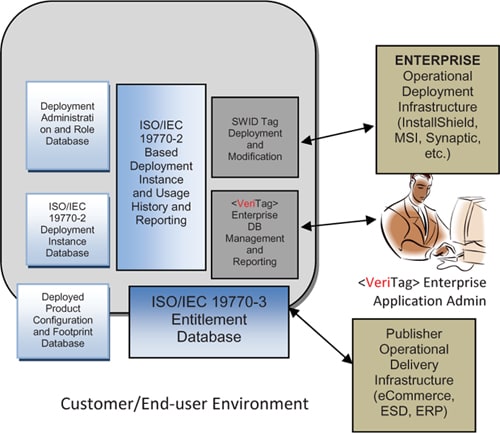Understanding exactly what licensable entities have been installed is one of the most difficult aspects of controlling software across a network. And the two criteria --- what's deployed against what's licensable -- don't always line up.
Many software suites and apps, for example, share installers between versions. As a result, it can be difficult to tell exactly what edition of a software application has been installed or how that application should be licensed using traditional software identification techniques (which are usually based on some kind of finger-printing methodology, the sophistication of which varies from one inventory solution to the next).
What is Software Identification Tagging?
As part of the contemporary world's key infrastructure, software is critical to our economy and way of life. Too frequently, cost and complexity make it impossible to efficiently maintain software, leaving it vulnerable to attack. Enterprises must keep accurate software inventories of their managed devices to correctly manage software in support of higher-level business, information technology, and cybersecurity tasks.
As a result, the concept behind SWID Tags is simple: software producers 'embed' metadata into software installs that inventory systems can read to improve the accuracy of essential information such as software publisher, product name, and version identification. SAM managers will be able to distinguish between complete and trial versions of software, network vs stand-alone installer, and track SaaS and cloud apps much more easily as a result of this.
The SWID Tag standardized the structure of this data so that, theoretically, any inventory tool should be able to read it and utilize it in the software recognition process. But hold on, there's a catch.
Software bill of materials (SBOM) and SWID
Organizations in a variety of sectors rely on open source and third-party software, but often have no access over the quality, security, or originator of the components. Software supply chains are vulnerable to assaults due to a lack of openness. To tackle this, the software bill of materials (SBOMs) was introduced so software components can be identified and described.
A software Bill of Materials (SBOM) is a list of all open source and third-party components that are included in a codebase. An SBOM also includes the licenses that govern those components, as well as the versions and patch status of the components utilized in the codebase, allowing security teams to immediately discover any security or license problems.
Because SBOMs are meant to be shared across enterprises and communities, having a standard structure (both human and machine readable) with consistent information is essential. SPDX, CycloneDX, and SWID are some of the recommended formats available.
Benefits
SWID ensures that software license agreements are followed. Knowing what software has been installed and utilized assists companies in avoiding paying for licenses that aren't needed. It also makes sure all software assets in use are compliant with company policy.
The attack surface area can be reduced by reducing and regulating an organization's software footprint. SWID tags verify that any software assets deployed are up to date and devoid of known exploitable flaws. Countering cyber dangers is as simple as making sure all software is patched and updated. They also assist in ensuring that all deployed software assets are configured in accordance with the security rules of the business.
Configuring defensive measures, limiting the number of services exposed, and restricting software features can all help to lower the attack surface and harden systems against assaults. Accurate software inventories identify essential software assets, allowing for focused and monitored inspections.
Finally, SWID plans for any softwares and resources needed to enable legacy system upgrades and replacements. Budgeting for IT investments can be made easier if you know what commercial and bespoke software the company employs.
SWID Life Cycle
While some vendors provide tools for managing licenses, updates, patches, and settings for their products, businesses must monitor and employ a variety of such tools to accommodate the wide range of products they use.
The great variety of technologies available, human error, and a lack of resources can restrict an organization's capacity to support active software management, preventing timely patching and causing settings to drift. Instead, a single method is required to assist enterprises in understanding the current condition of all software throughout the organization, independent of the vendor.
SWID Tags, as specified by the ISO/IEC 19770-2:2015 standard, promise to be a significant step in achieving this aim. Organizations may use SWID Tags to track the software installed on their controlled devices in a transparent manner.
SWID Tag files contain descriptive information about a software product's unique release. The SWID standard describes a life cycle in which a SWID Tag is applied to an endpoint during the installation phase of a software product and then removed during the uninstall process.
SWID Tags are used in multiple standards bodies, including the Trusted Computing Group (TCG) and the Internet Engineering Task Force (IETF). The National Institute of Standards and Technology recommends that software producers adopt the SWID Tag standard.
Security Considerations
Since SWID tags include public information about software components, they do not need to be safeguarded from endpoint exposure. Similarly, SWID tags are designed to be easily discoverable by applications and users on an endpoint so that all of the endpoint's SWID tags may be identified and collected. As a result, any security concerns around SWID tags are limited to the use of SWID tags to solve security problems and the potential disclosure of the outcomes of such applications.
If the SWID tag was produced by the software supplier, it is regarded as "authoritative". The maintainer of a software component, who is supposed to be an expert in their own programme, provides information about the software component in an official SWID tag. As a result, authoritative SWID tags may be relied upon to reflect authoritative software component information.
A verified signature on a signed SWID tag may be trusted to remain unmodified after it was signed. Unsigned tags, on the other hand, cannot be guaranteed to carry unaltered data.
Summary
In this article, we discussed software identification tagging, briefly discussed SWID tagging and its lifecycle, and its advantages with respect to license agreements, adhering compliance etc.
I hope you found this article informative and interesting.









Top comments (0)